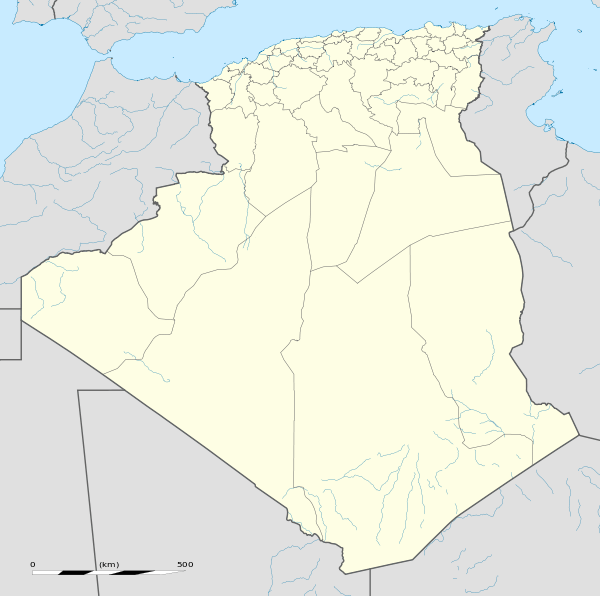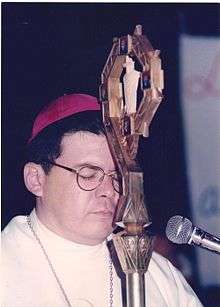Setifis
|
Roman remains in Sitifis | |
 Shown within Algeria | |
| Location | Algeria |
|---|---|
| Region | Sétif Province |
| Coordinates | 36°11′00″N 5°24′00″E / 36.183333°N 5.4°E |
Sétifis (Arabic: سطيف, SATIF, Berber STIF), was a town of in Roman in northeastern Algeria. It was capital of the Roman era province, and is today Setif in Sétif Province, Algeria.
Sitifis also known as سطيف, was officially Colonia Augusta Nerviana Martialis Veteranorum Sitifensium, and from the time of Diocletian, (293 A.D.), was the capital of Mauritania sitifienne (now eastern Algeria).[1] Today vestiges of the third century and fourth century include city walls, temple, circus, mausoleum and "Scipio" Byzantine fortress. Numerous archaeological artifacts are exhibited at the archaeological museum of the city.
.jpg)
The name of the city, is of Numidian origin and in Berber means "black" (aseṭṭaf). The modern city was founded by the French on the ruins of the ancient one.[2]
On the northwest edge of the town two great Christian basilicas were built at the end of the fourth century, decorated, again, with splendid mosaics,[3] and a Bishopric was founded at this time.
The city had a bath house[4] fortifications[5] The inhabitants made inscriptions to the emperors a practise that falls out in the 4th century with the rise of Christianity.[6][7] The city also has a Circus[8] the approximate location confirmed by old air photographs showing 90% of the circus has now been built over;[9] only the southern, curved, end remains visible. The U-shaped formerly visible track was c450m long and c70m wide.[10]
In 647 AD the first Muslim expedition to Africa took place and by 700 AD, the area had been fully conquered.
Bishopric
The city was also the center of a bishopric. The diocese effectively ceased with the Islamic invasion, but remains a titular see to the current day. Bishops known to us include:

- Novutus[11](Donatist)
- Unnamed Donatist bishop
- Lucullas (Catholic)
- Alexis Lemaître, (24 Feb 1911 Appointed - 28 Jul 1920 Appointed, Coadjutor Archbishop of Carthage)
- Joanny Thévenoud, (8 Jul 1921 Appointed - 16 Sep 1949)
- André-Maurice Parenty (9 Mar 1950 Appointed - 23 Nov 1983)
- Armando Xavier Ochoa (23 Dec 1986 Appointed - 1 Apr 1996 Bishop of El Paso, Texas)
- Manuel Felipe Díaz Sánchez (27 Feb 1997 Appointed - 4 Apr 2000 Bishop of Carúpano)
- John Choi Young-su (22 Dec 2000 Appointed - 3 Feb 2006 Appointed, Coadjutor Archbishop of Daegu {Taegu})
- Broderick Soncuaco Pabillo (24 May 2006 Appointed - )[12]
References
- ↑ Nacéra Benseddik, Autels votifs de la région de Sétif: païens ou chrétiens?, Monuments funéraires, institutions autochtones en Afrique du Nord antique et médiévale, VIe Colloque International sur L'Histoire et l'Archéologie de l'Afrique du Nord, Pau, 1993, C.T.H.S. [1995], p. 179-186.
- ↑ Leslie Dossey, Peasant and Empire in Christian North Africa (University of California Press, 2010)page 131.
- ↑ P.-A. Fevrier, Fouilles de Sétif: les basiliques chrétiennes du quartier nord-ouest Paris, 1965.
- ↑ Leslie Dossey, Peasant and Empire in Christian North Africa (University of California Press, 2010), p24.
- ↑ Leslie Dossey, Peasant and Empire in Christian North Africa (University of California Press, 2010) p113.
- ↑ Nacéra Benseddik, Nouvelles inscriptions de Sétif, B.A.A., VII, 1977-79, p.33-52.
- ↑ Leslie Dossey, Peasant and Empire in Christian North Africa (University of California Press, 2010), p24.
- ↑ Setif circus
- ↑ [Setif] The Circus | Circus at Setif at circusmaximus.us.
- ↑ Setif circus
- ↑ Saint Augustine, Robert B. Eno, S.S. Letters, Volume 6 (1*–29*) (The Fathers of the Church, Volume 81), Volume 6 (CUA Press, 1Apr.,2010 ) p186.
- ↑ http://www.catholic-hierarchy.org/diocese/d3s40.html